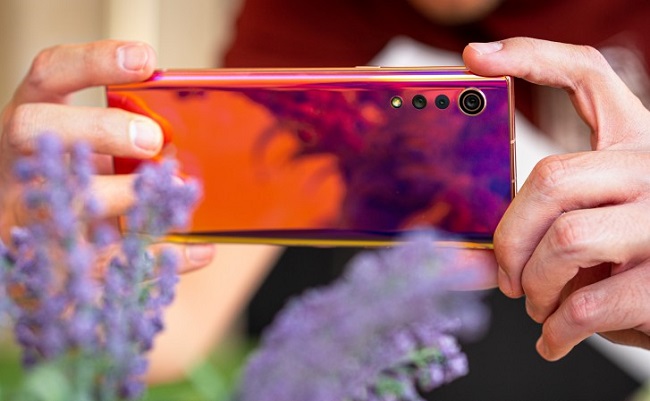With the LG G8X ThinQ, LG adopted a novel tack toward foldable smartphones. LG doubled the amount of usable screen space by using a cover with an additional display, while Samsung and Huawei were researching flexible panels that could unfold to convert a smartphone into a tablet.
The G8X ThinQ was a lot more durable thanks to the lack of a complex mechanism, and it was cheaper to produce. The LG Velvet, or LG Velvet 4G in some areas, is the latest example of this strategy from LG. Although the Velvet takes certain design cues from the LG G8X ThinQ, its inspiration, does it provide the same level of value? If you want to know, read my review.

LG Velvet Design
When compared to the LG G8X ThinQ, the LG Velvet’s main display is noticeably larger (Review). The LG Velvet is tall and slender due to its 6.8-inch screen and 20.5:9 aspect ratio. Hence, holding this smartphone poses no difficulty, but reaching the top of the screen does.
The Velvet weighs in at just 180g and measures 7.9mm in thickness, so it’s not too heavy to carry around. Its rounded screen design makes me think of smartphones from Samsung’s Galaxy S line. The edges of the back are also rounded. The item has a metal frame, and its sides are relatively thin. In general, the LG Velvet has a high-end feel.
LG Velvet Specifications and Software
The LG Velvet’s large 6.8-inch P-OLED screen can display images at a resolution of 2460 x 1080. The display specs for the dual-screen attachment are identical, including the absence of a camera in the notch. Both displays only refresh at 60Hz, while modern rivals offer displays with refresh rates of 90Hz and even 120Hz.
The Qualcomm Snapdragon 845 system-on-a-chip (SoC) powers the Velvet, which is quite surprising given that it is now quite old and cannot compete with modern chips in terms of performance. The Snapdragon 855 Processor found in the LG G8X ThinkQ was the more potent of the two.
The LG Velvet has 6GB of RAM and 128GB of storage, and there are no other configurations available. A second SIM can be used for additional storage in a hybrid dual-SIM tray. The LG Velvet has a number of different wireless networking choices, including Bluetooth 5.1, dual-band Wi-Fi ac, and dual 4G VoLTE. It also has stereo speakers, which is a nice touch.
LG Velvet Performance & Battery
When compared to the LG V60, the LG Velvet’s hardware falls short. Although the Snapdragon 865 is the superior chipset, LG chose the Qualcomm Snapdragon 765G for good reason. One money- and space-saving feature is the built-in 5G modem.
This allowed LG to cover the sub-6GHz 5G spectrum while yet keeping the phone small. The remainder of the specs, fortunately, aren’t terrible. LG equipped the phone with 6GB of RAM and 128GB of storage space.
These features aren’t very cutting-edge, but they’re adequate for a “excellent” phone in 2020. In practical testing, the phone lagged behind contemporary flagships in terms of responsiveness. When navigating between apps, there was noticeable lag, and menus were slow to open. While not a show-stopper, this isn’t what we’d expect from a mid-tier smartphone in 2020.
LG Velvet Camera
There are four total camera sensors on the LG V60, three on the back and one up front. This is the standard setup for a premium smartphone. The LG Velvet takes passable, but unremarkable photos. The phone has a respectable dynamic range, however photos were typically underexposed until a 2x magnification was applied.
Some colors might be too low on luminance, while others would be too high, but overall, each camera had a fairly consistent color profile. The darker blues became more darker, while the yellows and reds became more muted.
The overall haziness of the photos suggested that the cameras were suffering from a lack of illumination. LG, unlike some competitors, is not employing a massive sensor on this phone, which may account for its relative gentleness.
The images came out looking muddy all over. When I tried to zoom in any farther than 2x, the photos utterly disintegrated. The phone has a 10x optical zoom, but I wouldn’t use it for anything but an emergency. The 10x magnification made the obtained images appear extremely soft and washed out. The image quality when zoomed in on many other phones is far higher.
Conclusion
Before finally leaving the smartphone market, LG had a tumultuous couple of years. The company has lost a lot of its brand value despite producing phones that cater to its core customers’ preferences. LG’s design stagnation and software reluctance are to blame to some extent for this.
The LG Velvet’s aesthetics are arguably its best selling point. Since their inception, LG’s flagship devices have changed little in appearance from one generation to the next. While this isn’t necessarily a bad thing, it has made the company’s phones seem antiquated. The LG V60 is LG’s most cutting-edge design to date, but it’s not perfect.









































